Energy generation by using petroleum, gas and, coal lead to greenhouse gas emission and other environmental pollution. But we need energy sources to fulfill our essential day-to-day life requirements at the same time it should not affect our environment as well. So, we are in a situation to create clean energy. That is how the alternative energy generation techniques like solar energy, wind energy, hydropower plants, wave energy, tidal energy, geothermal energy, and ocean thermal energy, etc., came into play.
In this article, we are going to see how we can convert wave energy into electrical energy. Before that, we should know the difference between wave and tidal energy. Because most of the people often confuse with the term waves and tides.
Tides cause changes in the depth of the ocean, this cyclic occurrence of rising and falling of the water surface happen due to the gravitational pull of the moon. The rising and falling of the water level (Tides) create the kinetic energy that is used to run the turbine to generate the electricity.
The differential temperature of the earth causes pressure differences in the atmosphere, that generate winds. Waves are formed because of the wind that blows over the surface of the water which causes friction. That friction between wind and the surface water make the up and down movement of the water called waves. The wave energy generators use the kinetic force of waves to produce energy.
Point absorbers convert energy by absorbing the up and down motion of the waves which acts on the floating buoys that convert the mechanical motion into electricity. The oscillatory motion created by floating buoys makes the absorbers to act as a hydraulic pump which is used to rotate a turbine to generate electricity.
The OWC is usually constructed near to the rocks or cliffs which are next to the deep-sea bottom. Then only, we can utilize more wave energy. It consists of a partly submerged hollow chamber which is fixed directly at the shoreline to capture the wave energy. When the wave enters and exits the chamber, the water surface oscillate up and down within the chamber that acts as a piston on the air above the surface of the water. This oscillatory motion compress and decompress the air on every cycle. This air pressure is properly channeled to rotate the wind turbine to generate electricity.
This device converts the waves into potential energy by lifting the water into a reservoir which is installed near the shoreline. When the waves hit the ramp of the reservoir, it flows over that tapered surface and stored into a raised water impoundment reservoir. This trapped water creates the potential energy inside the reservoir which is then extracted by using gravity. So, the water moves down that helps to generate the electrical energy by using the low-head Kaplan turbine. The turbine is usually fixed at the bottom of the device.
The OWSC extracts energy by using wave movements. The OWSC comprised a hinged defector that is installed perpendicular to the wave movements. So, the ocean's wave movement make this defector oscillate like a pendulum that is used to actuate a hydraulic piston connected to it; These pistons convert the kinetic energy of the defector into electrical energy.
In this article, we are going to see how we can convert wave energy into electrical energy. Before that, we should know the difference between wave and tidal energy. Because most of the people often confuse with the term waves and tides.
Tides cause changes in the depth of the ocean, this cyclic occurrence of rising and falling of the water surface happen due to the gravitational pull of the moon. The rising and falling of the water level (Tides) create the kinetic energy that is used to run the turbine to generate the electricity.
The differential temperature of the earth causes pressure differences in the atmosphere, that generate winds. Waves are formed because of the wind that blows over the surface of the water which causes friction. That friction between wind and the surface water make the up and down movement of the water called waves. The wave energy generators use the kinetic force of waves to produce energy.
Wave Energy Conversion Devices
- Point absorber
- Oscillating water column
- Overtopping wave power device
- Attenuators
- Oscillating wave surge converter
- Submerged pressure differential
Point absorbers convert energy by absorbing the up and down motion of the waves which acts on the floating buoys that convert the mechanical motion into electricity. The oscillatory motion created by floating buoys makes the absorbers to act as a hydraulic pump which is used to rotate a turbine to generate electricity.
Oscillating Water Column
OWC converts the wave energy into the air pressure.
The OWC is usually constructed near to the rocks or cliffs which are next to the deep-sea bottom. Then only, we can utilize more wave energy. It consists of a partly submerged hollow chamber which is fixed directly at the shoreline to capture the wave energy. When the wave enters and exits the chamber, the water surface oscillate up and down within the chamber that acts as a piston on the air above the surface of the water. This oscillatory motion compress and decompress the air on every cycle. This air pressure is properly channeled to rotate the wind turbine to generate electricity.
Overtopping Wave Power Device
This device converts the waves into potential energy by lifting the water into a reservoir which is installed near the shoreline. When the waves hit the ramp of the reservoir, it flows over that tapered surface and stored into a raised water impoundment reservoir. This trapped water creates the potential energy inside the reservoir which is then extracted by using gravity. So, the water moves down that helps to generate the electrical energy by using the low-head Kaplan turbine. The turbine is usually fixed at the bottom of the device.
Attenuators
The attenuator is a floating device which is operated by using the waves that pass along the length of the device. As the waves move along the device, that makes the attenuator body to float up and downwards. The connecting joints of the attenuator device flex due to waves which are used to exert the force to give power to the hydraulic rams at each joint. The hydraulic ram drives oil which rotates the turbine to generate electricity.
Oscillating Wave Surge Converter
The OWSC extracts energy by using wave movements. The OWSC comprised a hinged defector that is installed perpendicular to the wave movements. So, the ocean's wave movement make this defector oscillate like a pendulum that is used to actuate a hydraulic piston connected to it; These pistons convert the kinetic energy of the defector into electrical energy.
Submerged Pressure Differential
This device is mounted on the seafloor near to the shore. The waves motion cause the sea level to rise and fall above the device that induces the pressure differential on the device. The pressure is used to pump the fluid within the system to generate electricity.
Conclusion
The above-explained technologies produce no greenhouse gas emissions making it non-polluting renewable source of energy. However, capturing the wave energy and converting them into electricity is a little difficult compared to other alternative energy conversion techniques and also a costlier process. There are many kinds of research going across the world to make the wave energy conversion more efficient and also to develop the existing techniques which are explained in this article.
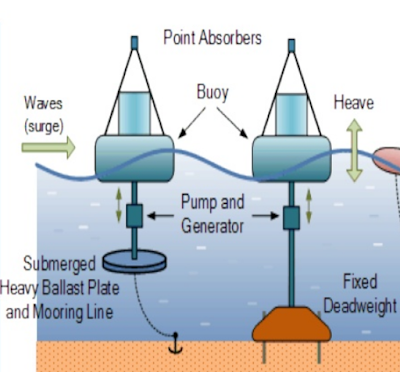
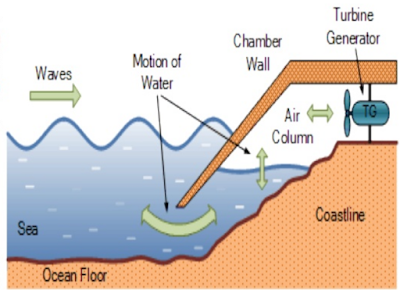
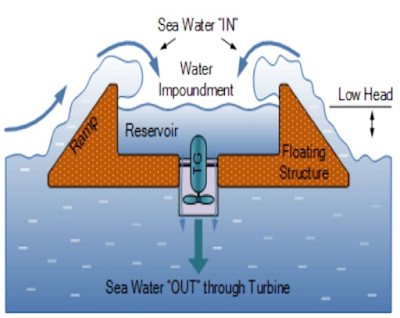
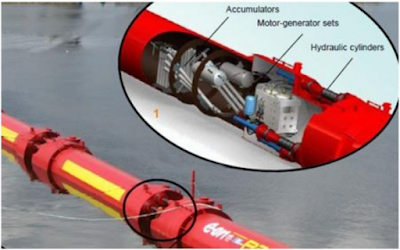

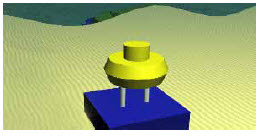
Comments
Post a Comment